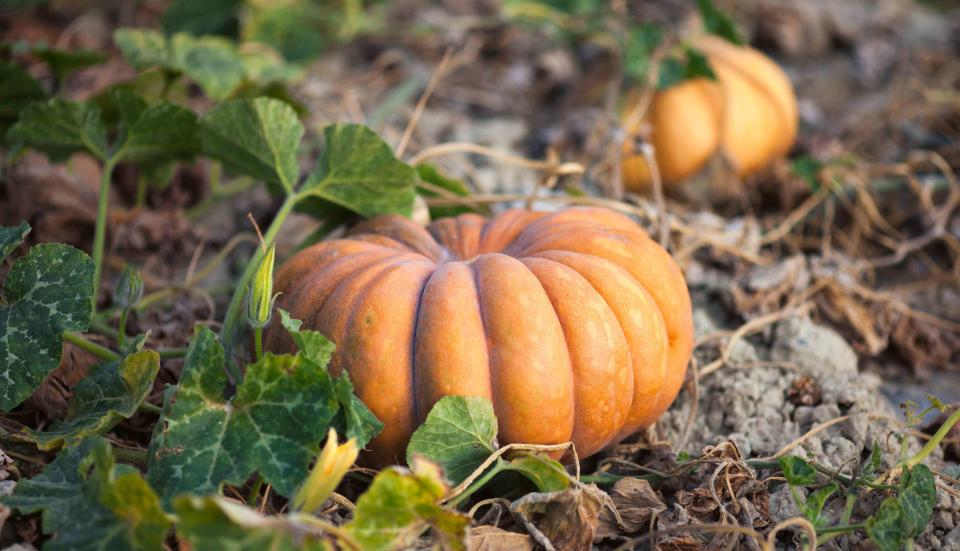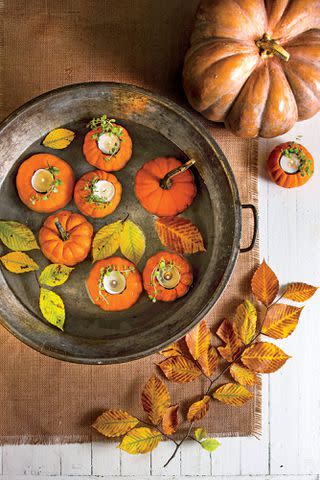The Best Time To Plant Pumpkins For Fall Decor, According To Gardening Experts
Want to grow your own pumpkins for fall decor? Here's what to know.

Sierra Lemon/Getty Images
Do you love decorating your home with pumpkins for fall? Consider growing your own decorative pumpkins. Pumpkins, part of the squash family, are easy to grow. Pumpkins love plenty of sun and nutrient-rich soil, and in around three to four months after planting, you'll be reaping what you sow. Growing decorative pumpkins is a fun and rewarding activity whether you're an experienced gardener or have a budding curiosity. "Anyone who enjoys fall decorations and wants to add a festive touch to their home should consider growing a pumpkin for fall decor," says Laura Root, Horticulturist and Senior Product Manager for Park Seed.
Related: 30 Best Pumpkin Decor Ideas to Try This Fall
Meet The Experts
Laura Root, Horticulturist and Senior Product Manager for Park Seed
Kristen Noble, Vegetable Product Manager of Harris Seeds and National Garden Bureau member
Greg Key, founder of Hoss Tools and National Garden Bureau member
Whether To Grow From Seeds Or Seedlings
Every gardener has to decide whether to grow vegetables and fruits from seeds or seedlings.
Growing From Seeds
Choosing seeds is more cost-effective than buying seedlings, offers more varieties to choose from, and gives you more control over when you plant but takes more time. "Starting from seeds gives gardeners greater time flexibility, allowing them to begin the growing process according to their preferred schedule and adapt to local climate conditions," says Root.
Pumpkins germinate easily, making them a great choice to grow from seed. "Pumpkins are easy to grow from seeds and can be direct sown after the soil warms in late spring," says Kristen Noble, Vegetable Product Manager of Harris Seeds and National Garden Bureau member.
Growing From Seedlings
Opting for seedlings—small plants that are ready to put in the ground—can be easier and save time but cost more. Plus, you're often limited to what your local nursery has available. Noble adds, "Others may choose to grow from seedlings if they have a short growing season." Most seeds or seedlings are planted after the last frost has passed and when the topsoil is around 60 degrees Fahrenheit.
Pumpkin Varieties
When it comes to growing decorative pumpkins for fall decor, there are numerous varieties to choose from. Selecting the types to grow comes down to personal taste, decorative goals, and choosing varieties that grow well in your geographical region. "The best pumpkins to grow for fall decor depends entirely on your preferences and the style you’re going for," says Noble. The beauty of growing your own is finding cool varieties with different shapes and colors—not all pumpkins are bright orange. Her favorite decorative varieties include Fireball, Blanco, Fairytale, and Miniwarts. Root likes Wee-B-Little Pumpkin and Jarrahdale Pumpkin for fall decor.

How To Grow Pumpkins
Pumpkins are easy to grow as long as their care requirements are met. Pumpkins are best grown directly in the soil or in a raised bed so they have space to grow and spread out; they are a vining plant after all!
What You'll Need To Grow Pumpkins
Soil: Grow pumpkins in well-draining soil that is amended with compost.
Water: Pumpkins do best when the soil is kept moist but never soggy. "You can check if the soil is dry, or observe the leaves of the plant, which should be upright and open when the plant has adequate water," explains Noble. She says these plants need regular watering, especially once the fruit begins to form and grow.
Sunlight: Pumpkins are sun-loving plants. Grow them in an area of your garden that receives around six hours or more of sunlight each day.
Mulch: Place a layer of mulch, such as leaves or straw, a couple of inches away from the base of the plant after transplanting your pumpkins. Mulching acts like a blanket for the soil– maintaining warmth and retaining moisture. Mulch also suppresses weeds, provides a barrier between the pumpkin touching the soil and minimizes soil from splashing after watering. Noble says mulching keeps the plants and fruit clean and reduces pathogens from spreading.
Related: How Long Does It Take To Grow A Pumpkin?
Common Pumpkin Diseases
Pumpkins are prone to diseases that can spread easily and affect a crop. Powdery mildew is spread by spores that produce a white powder on the leaves. Downy mildew is another common fungal disease that turns the leaves light green with splotches of yellow. "As the plants grow, it is also important to monitor for disease and remove any infected leaves before it spreads to younger leaves," says Noble. One way to minimize the chance of these mildews is watering your pumpkins near the base of the stem. "The use of drip irrigation can assist in keeping disease at bay," says Greg Key, founder of Hoss Tools and National Garden Bureau member.
Using a hose or sprinkler system that sprays the entire plant can spread this mildew quicker. "Leaf wetness from overhead irrigation can make the diseases worse," he adds. Want to mitigate these mildews? "Plant in an area that has good air circulation. This will help keep the leaves drier and less prone to disease," says Key.
When And How To Harvest
You've planted, you’ve watched the seedlings grow, you've watered, and seen the plant bear fruit. Now you're wondering, “When is it time to harvest?” The timing will vary based on the variety. The good news is you'll see signs when it's harvest time. "A pumpkin is ready to harvest when the stem has started to dry, and the plant is beginning to decline," says Noble. "These are indicators that the fruit has matured, which will help them last longer after picking." Observe the stem for clues, too. "The stem should also be drying out and starting to crack," says Root.
Harvest Tip
Use a sharp knife to harvest. According to Noble, "It is best to cut the vine away from the stem rather than cutting the stem itself. This will also help the fruit last longer after picking."
For more Southern Living news, make sure to sign up for our newsletter!
Read the original article on Southern Living.

